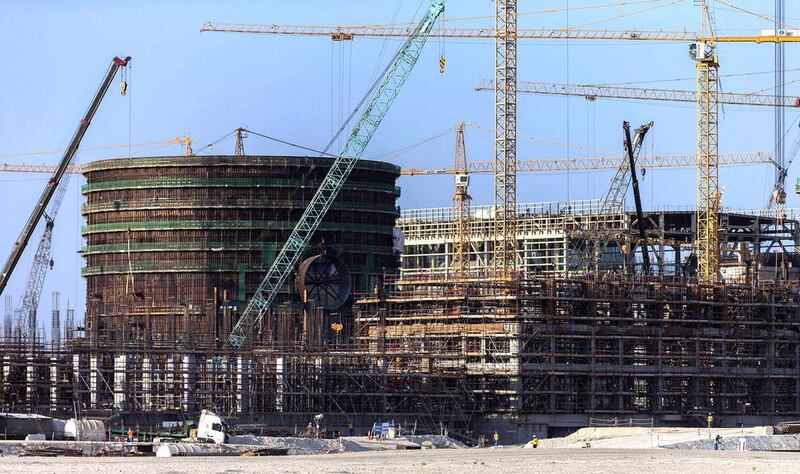Abu Dhabi’s Western Region is targeting rapid economic and jobs growth over the next decade based around large-scale energy sector projects, according to senior industry figures.
The huge Al Hosn gas project, which started production this year, as well as the Barakah-based nuclear programme, the Bab sour gas project near Madinat Zayed and expansions of the Ruwais oil refinery complex will be among the biggest contributors to economic expansion in the region known as Al Gharbia, according to Atiq Khamis Hamad Al Mazrouei, the acting director general of Western Region Municipality.
Mr Mazrouei told an annual Al Gharbia development conference, run by Middle East Economic Digest, that the region is seeking to attract entrepreneurs and investment for the multitude of contracts that includes direct support for the major energy projects, and a wide range of other projects to fulfil goals on tourism, agricultural and fisheries, as well as a number of large building and infrastructure projects to develop trade with GCC countries.
Abu Dhabi National Oil Company (Adnoc) will play a big part in Al Gharbia's rapid growth, according to Saif Ahmed Al Ghafli, the chief executive of Al Hosn Gas, which is 60 per cent owned by Adnoc.
Adnoc’s two US$10 billion gas projects – Al Hosn’s Shah gasfield, in which Occidental Petroleum has a 40 per cent stake, and the Bab gasfield which is owned 40 per cent by Royal Dutch Shell and 60 per cent by Adnoc – are expected to produce thousands of permanent jobs and spur local economies, Mr Al Ghafli said.
The landmark Shah gas project, which is one of the biggest of its kind in the world, is expected to deliver 500 million standard cubic feet a day of gas to the UAE system, or 10 per cent of the country’s needs, when it reaches full capacity this quarter, Mr Al Ghafli said.
Over the 30-year life of the project there will be about 1,300 full-time Al Hosn employees based in the city of Liwa who will need to be housed and have all the usual services available, he said
"You are talking about a similar exercise to what we've seen at Al Hosn" for the Bab gas project, with similar levels of employment when it reaches first gas production, expected in 2020, he said.
Bab is based in the Habshan area of Al Gharbia, just north of Madinat Zayed. The Bab project is at a much earlier phase than Al Hosn’s Shah development.
“The Bab project is progressing smoothly and we are currently finalising the pre-feed [front end engineering design] stage and there is an ongoing appraisal programme,” the Shell spokesman Ali Nasir Khan said yesterday. “We are satisfied by the results and we continue to work together with our partner Adnoc towards establishing the new joint venture according to the agreed work programme.”
Another huge energy project that will create thousands of jobs in the region is the Emirates Nuclear Energy Corp’s reactor-building programme, which is expected to produce 25 per cent of the UAE’s electricity when completed.
Mohamed Al Hammadi, the Enec chief executive, said that the first of four planned reactors is 70 per cent complete, with the main dome already built and cable work currently under way.
The reactor is on track to be operational by 2017.
“The Al Gharbia region will absorb a huge amount of labour by 2020”, when all four reactors are up and running, Mr Al Hammadi said. Enec is expecting to employ about 2,000 directly by then and “according to global studies it is expected that for each direct employee there is another six support employees required”, ranging from transport to health care.
He added that $1.2bn of contracts have already been awarded to Emirati companies by Enec with more to come.
The energy projects are expected to drive wider business growth in the region as huge infrastructure is added, including the country’s first railway to deliver sulphur from the sour gas projects to the Ruwais processing plant and port.
“The investment potential and capabilities of Al Gharbia are a major attraction for foreign investors, especially with major development projects underway in energy, tourism, manufacturing and agriculture,” said Mohamed Hamad bin Azzan Al Mazrouei, undersecretary of the Ruler’s Representative Court in the Western Region.
Al Gharbia covers an area of 40,000 square kilometres, which is about 60 per cent of Abu Dhabi emirate’s land mass, but has a population of only about 200,000.
The industrial development aside, it is one of Abu Dhabi’s most diverse and attractive environments, with desert dunes and 350 kilometres of unspoilt coastline, as well as nature reserve islands.
amcauley@thenational.ae
Follow The National's Business section on Twitter





